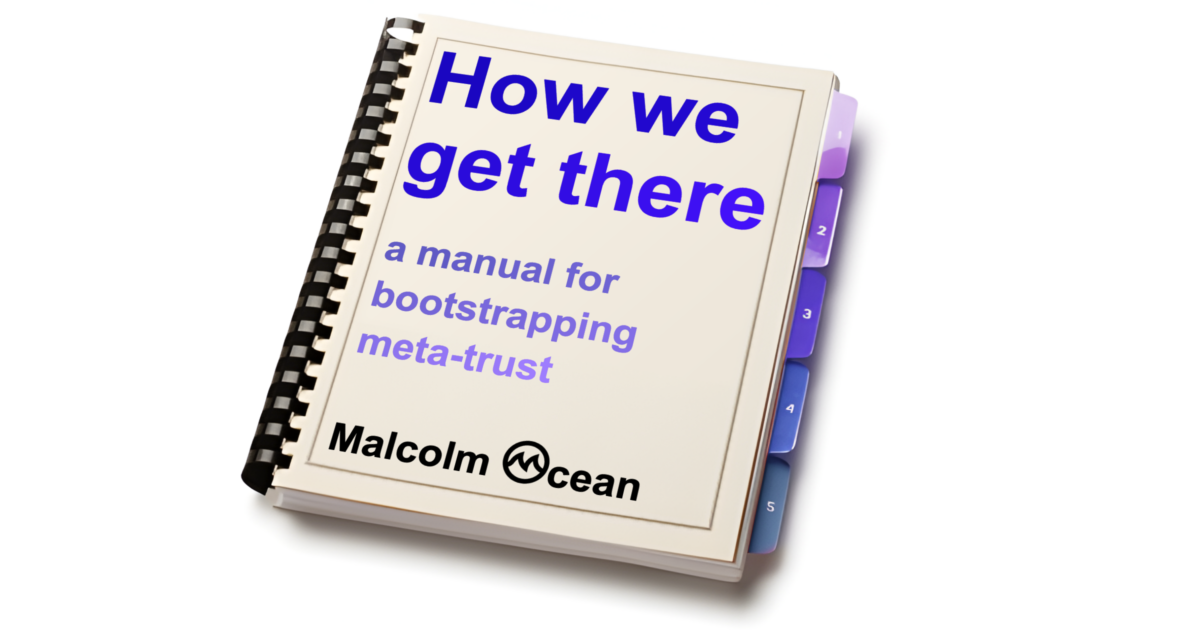A few years ago, I was sharing some of my visions (eg this one or my 100× vision) with a friend and he said “that’s cool but how do we get there?” so I went to doc.new (which, if you didn’t already know, makes a new google doc!) and typed in the title field “How we get there” and proceeded over the following weeks to pour out over 20 thousand words on the topic!
It had a very “say the obvious” feel—I was just articulating what had recently become obvious—what followed from my non-naive trust dance insight in 2020. It doesn’t actually make that many references to the phrase “trust-dancing”, but it describes the core dynamics involved in navigating the dance of trust and distrust, with a closed group of people or with a group of people that is growing. But—which may or may not be obvious to you—what’s obvious to me isn’t going to be obvious to everybody, and that’s why it’s good to say the obvious.
My original purpose was to share it with a few close collaborators, to help us get in sync (which is part of how we get there!) but I found that I was really excited about the writing and shared it with a couple dozen friends or connections I knew less well when it seemed relevant, and eventually I tossed it up on gumroad for sale as a pdf…
…and promptly told almost nobody. I made like one tweet, and this short post on the same ideas, which links to it at the bottom.
But then this week somehow someone came across it, and bought it, which prompted me to tweet about getting my first book sale, which resulted in seven nine more people buying it, multiple of whom said “I had no idea this existed! you need to talk about it more!” so I figured I would more properly announce it on my blog!
So, without further ado, here’s the link to buy the book on gumroad! Or push this button:

I expect this piece of writing to be quite useful for people who are (or want to be)
…and of general interest to:
» read the rest of this entry »did I ask you to read this? did you come here because someone sent you?
I don’t pretend to understand
except when I do
there’s not an ounce of joy in these fingers
the stiffness sticks, waiting for movement moment
one thumb down, one thumb up
die
live
context-consciousness creating self-consciousness, as the soul waffles between speaking an utterance that will float away on the breeze and be lost to clouds… and articulating new Canon for The Book
if I write a book, it may out-live me
if I write a book, it may kill me a little
not the hours spent writing it, though they will surely be gone
but the artifact itself, static in a changing world
tens of thousands of copies—hundreds of thousands if I’m lucky
—of words attributable to me, uneditable
they’d better be good!
but, unless I go mad, they can’t be as good as my new understandings months or years or decades hence
and yet I saw a book get a new edition with so many additions its lost its life too
director’s cuts that preview to laughs
the author is dead
the work is alive
the work is not in the words, it’s in the dance
it’s in the remixes, not just the mashups that show up cited but in the tickling of axons and dendrites in each person who reads it
you know what I mean?
who cares if you know what I mean? why do they care?
I ask because I care: it seems to me that in the absence of some specific caring, we can’t even begin to answer the question of whether you know what I mean
the faucet, having sputtered at first, has begun to flow
and so I depart

What do you want? Great, go get it. Tomorrow, maybe.
This is better advice for some things than others. To use a trivial example, say you’re part of a business that involves selling directly to clients. And your goal is to grow sales by X% this year. Well, you can’t reach out and directly move the dial on how much product the company has sold. What you can do is make more sales calls. Just remember: what ultimately matters isn’t the number of calls but the annual sales.
The 4 Disciplines of Execution (great pdf summary here) calls this distinction “lead measures” vs “lag measures”. Lead measures are the ones that you can influence directly, in the short term. They tend to be relatively “instrumental“—not things you want intrinsically, so much as things you want because they help you get things you do want intrinstically. The lead measures that you choose for a given situation represent a belief you have about the best way to influence the lag measure. For the most part, you’d happily choose a different lead measure if you thought that’s what could get you closer to the goal.
Briefly, some examples that follow this pattern:
My blog post titles have been getting weirder and weirder. This one’ll make sense by the end, I swear.
At recommendation by Kenzi at the Center for Applied Rationality, I’ve been reading the book Eat That Frog by Brian Tracy right now, which is based around the following premises:
“You will never be caught up.”
“There is never enough time to do everything, but there is always enough time to do the most important thing.”
However, this only works if you actually have the focusing ability to turn [intending to do the most important thing] into not just doing it but finishing it. And you need to be able to trust yourself to do that. This post explores a particular kind of failure mode that occurs if you don’t have that kind of trust.
The titular frogs refer to » read the rest of this entry »